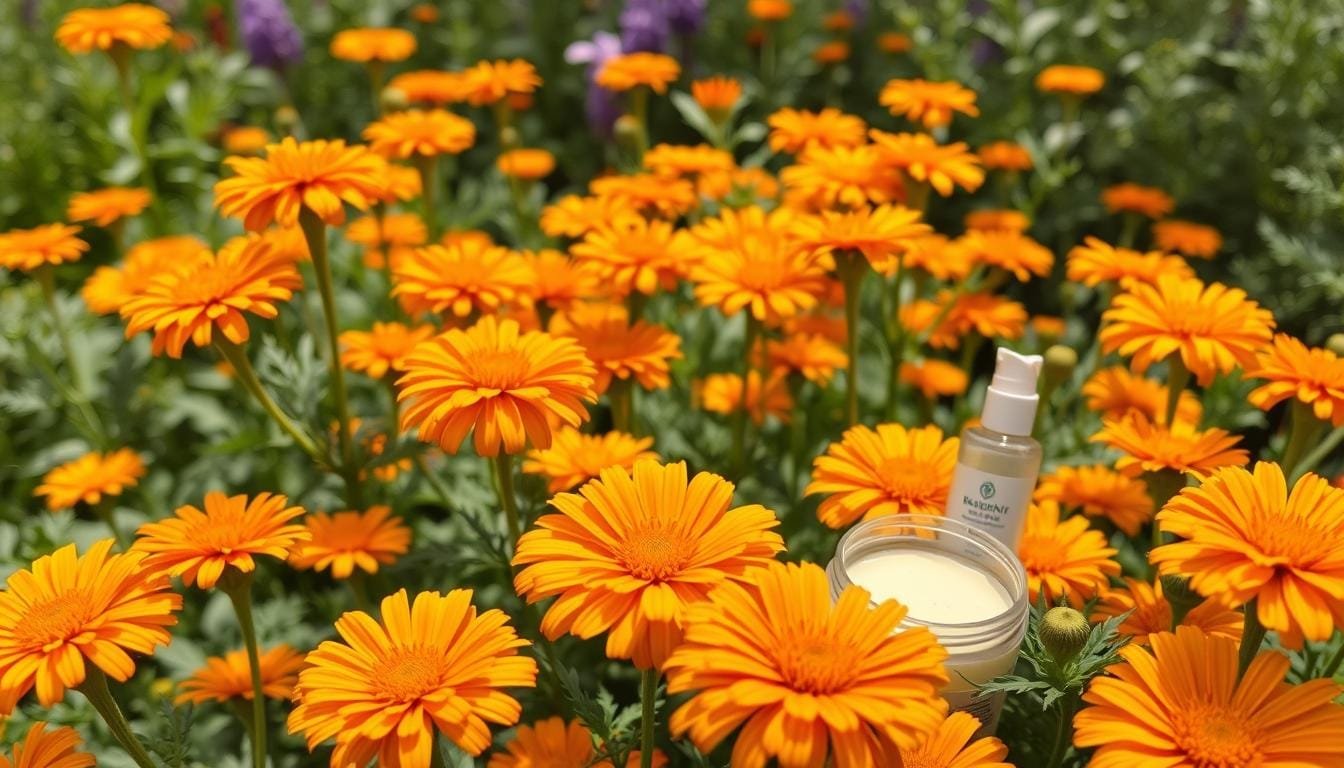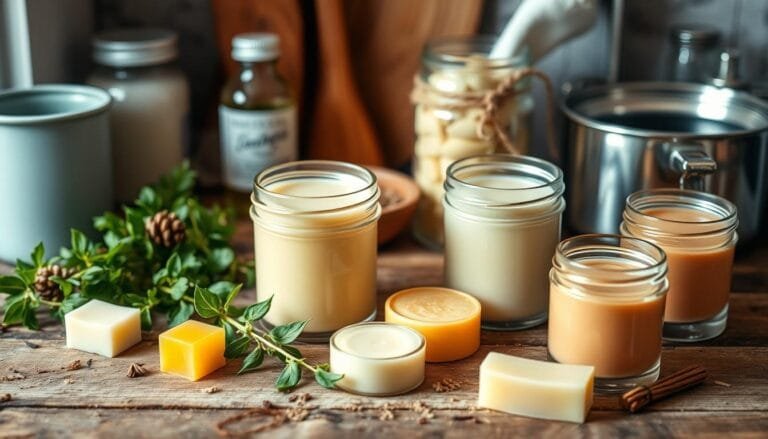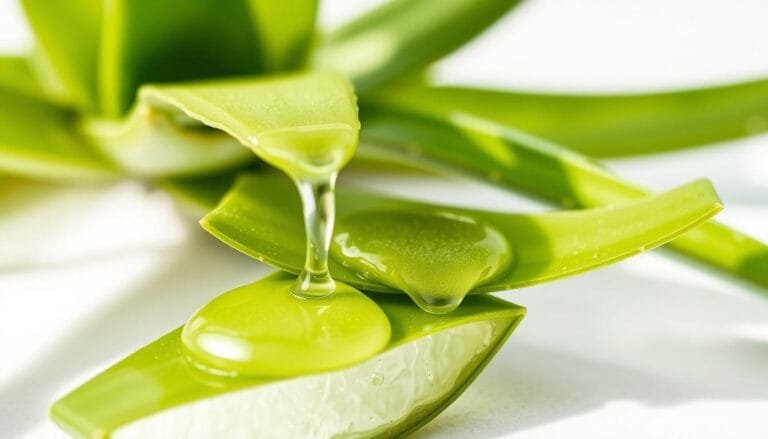I’ve grown to love calendula, a herb that’s great for skin health. It comes from North Africa and Eurasia. People have used it for centuries in Ayurvedic and Unani medicine.
Calendula has special compounds that help the skin. These compounds fight off damage and reduce swelling. It’s great for soothing irritated skin and helping wounds heal faster. You can use it in oils, infusions, powders, or creams.
In this guide, we’ll look at how calendula heals the skin. We’ll talk about its different forms for skincare and how to use it for various skin issues. By the end, you’ll know how to use calendula to make your skin healthy and glowing. It’s all about natural, herbal remedies.
Understanding Calendula: From Garden to Skincare Essential
Calendula officinalis, also known as the “pot marigold,” is a beautiful flower. It’s known for its health benefits and use in skincare. Unlike the common marigold, calendula is a unique plant with its own special compounds.
The History of Calendula in Traditional Medicine
Calendula has been used in medicine for centuries. Ancient Greeks, Romans, and Egyptians valued it for its healing powers. Its bright orange flowers helped treat many skin problems, like wounds, burns, eczema, and inflammation.
Key Compounds in Calendula Flowers
Calendula’s strength comes from its phytochemicals. Its flowers are packed with flavonoids, carotenoids, and triterpene saponins. These compounds help protect the skin, reduce inflammation, and aid in healing.
- Flavonoids like quercetin, isorhamnetin, and kaempferol provide powerful antioxidant protection.
- Carotenoids such as beta-carotene, lutein, and zeaxanthin lend the flowers their vibrant color and additional antioxidant properties.
- Triterpene saponins, including calendulosides and oleanolic acid, exhibit anti-inflammatory effects that can aid in wound healing.
These compounds make calendula a standout in skincare. It’s far more than just a pretty flower.
“Calendula has been used for centuries in traditional medicine to treat a wide range of skin conditions, from wounds and burns to eczema and inflammation.”
The Science Behind Calendula’s Skin-Healing Properties
Calendula, a marigold plant, is known for its skin health benefits. It has many phytochemicals that help its skin-healing abilities. Terpenoids like lupeol and beta amyrin reduce inflammation in the skin. Phenolic compounds and saponins give it antibacterial properties.
Studies show that calendula increases blood flow to wounds, helping them heal faster. Its carotenoids help new skin cells grow. Linoleic acid in the plant moisturizes and nourishes the skin. It also boosts collagen, making fine lines and wrinkles less visible.
A study in Acta Pol Pharm in found calendula extract improves human skin. Research in Phytother Res in 2015 showed it protects against oxidative stress and cell damage in human skin cells.
Calendula’s versatility is seen in a study in Planta Med in 2006. It found that Calendula officinalis flower extract can act as both a protector and promoter in a rat model.
| Skin Benefit | Supporting Research |
|---|---|
| Anti-inflammatory properties | Terpenoids like lupeol and beta amyrin provide anti-inflammatory effects |
| Antibacterial properties | Phenolic compounds, including flavonoids and phenolic acids, along with saponins, contribute to calendula’s antibacterial properties |
| Wound healing | Calendula increases blood flow to wounds, promoting faster healing, as evidenced by a study published in Int J Tissue React in 2005 |
| Skin regeneration | Carotenoids in calendula stimulate the regeneration of new skin cells, while linoleic acid moisturizes and nourishes the skin |
| Collagen production | Calendula boosts collagen production, reducing the appearance of lines and wrinkles |
Scientific evidence highlights calendula’s remarkable skin-healing properties. It’s a trusted ingredient in natural skincare. Always talk to a dermatologist before using calendula products to ensure they’re right for you.

Different Forms of Calendula for Skincare Applications
Calendula, the vibrant yellow-orange flower, is great for many skincare uses. You can use it in essential oils, powders, and creams. It helps with inflammation and wound healing.
Essential Oils and Infusions
Calendula essential oil is very popular. You can use it alone or mix it with other oils. Calendula infusions, made by soaking the flowers in water or oil, are also great.
Powders and Tinctures
Calendula powder is good for wounds and infections. It’s also used in homemade masks and skincare recipes. Calendula tinctures, made with alcohol, offer easy skin-soothing benefits.
Creams and Ointments
Calendula is in many skincare products like creams and ointments. These products use its anti-inflammatory and antioxidant properties. They help with acne and eczema.
Calendula is natural and versatile for your skin. You can choose from ready-made products or make your own. It’s perfect for healthy, radiant skin.
Using Calendula for Skin Health: Natural Treatment Methods
Calendula is a top choice for natural skincare. This bright yellow flower, also known as pot marigold, has been used for centuries. It’s known for soothing, healing, and protecting the skin.
Calendula balms and ointments are great for irritated or inflamed skin. They’re good for eczema, psoriasis, rashes, and even hemorrhoids. This is because calendula has anti-inflammatory and wound-healing properties.
Calendula can also be used in facial toners. Just steep dried calendula flowers in water to make a soothing infusion. You can use it as a toner or mix it with other skincare products. It’s also good in natural soaps, scrubs, and sunscreens.
| Product | Benefits | Key Ingredients |
|---|---|---|
| Babo Botanicals Calendula Repair Ointment | Soothes irritated skin, promotes healing | Calendula, shea butter, jojoba oil |
| Eminence Organics Apricot Calendula Nourishing Cream | Hydrates and conditions sensitive skin | Calendula, apricot, shea butter |
| Eminence Organics Calm Skin Chamomile Cleanser | Gently cleanses and soothes redness | Calendula, chamomile, aloe vera |
Adding calendula to your skincare routine can help with many skin issues. It’s good for inflammation and signs of aging. You can use it in ointments, infusions, or cleansing products. It’s a great tool for healthy, glowing skin.
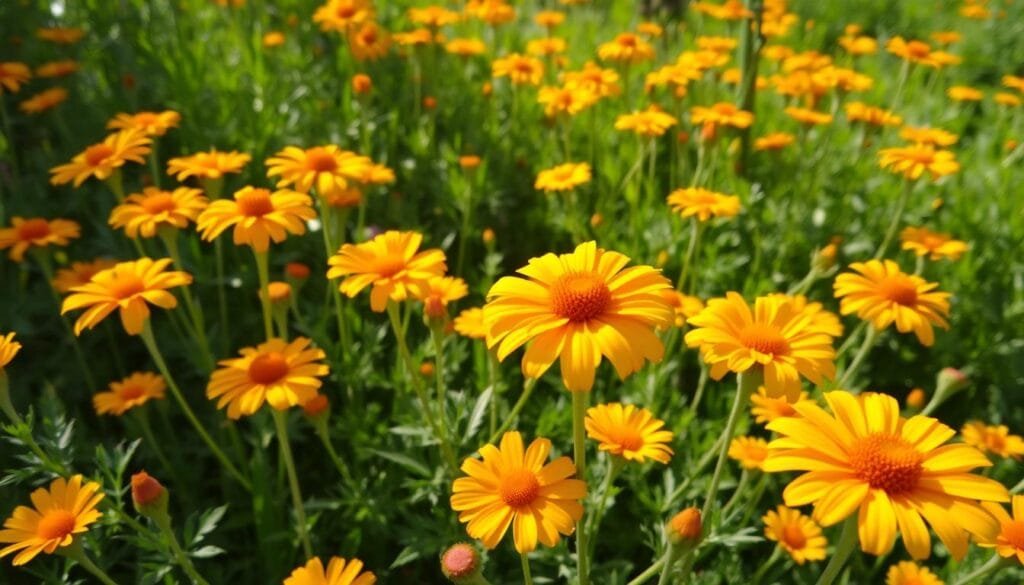
“Calendula has been studied and found to exhibit various properties beneficial for skin health, including antibacterial, antiviral, anti-inflammatory, anti-tumor, and antioxidant properties.”
Powerful Benefits of Calendula for Various Skin Conditions
Calendula, a vibrant orange-yellow flower, is known for its amazing skin-healing powers. It’s a key ingredient in many natural skincare products. Let’s see how it helps with different skin problems.
Anti-inflammatory Properties
Calendula contains compounds that fight inflammation. These help with acne, rosacea, and eczema. It reduces redness and swelling, making your skin look healthier.
Wound Healing Capabilities
Calendula speeds up wound healing. It boosts blood flow to the wound, helping it repair faster. Its antibacterial properties also protect against infection.
Antioxidant Protection
Calendula is full of antioxidants like lutein and zeaxanthin. These protect your skin from damage caused by the environment and UV rays. They help prevent early signs of aging and improve skin health.
For acne, eczema, or to rejuvenate your skin, try calendula products. Its many benefits make it essential for any skincare routine.
“Calendula is a gentle, yet powerful botanical that can address a wide range of skin concerns. Its natural healing properties make it a versatile choice for achieving healthy, radiant skin.”
| Skin Condition | Calendula’s Beneficial Effects |
|---|---|
| Acne | Reduces inflammation and redness |
| Eczema | Soothes irritation and promotes healing |
| Sun Damage | Provides antioxidant protection against UV rays |
| Minor Wounds | Accelerates wound healing and prevents infection |
How to Make Your Own Calendula-Infused Skincare Products
Making your own skincare with calendula is rewarding and natural. Calendula, or pot marigold, has been used for centuries for its skin-healing properties. By making your own calendula remedies, you can enjoy its benefits at home.
Calendula-Infused Oil
To start, make an infused oil with calendula Officinalis flowers. Use dried flowers and a carrier oil like olive or coconut oil. The mix should be 3 parts olive oil to 1 part coconut oil. Or, heat the oil and flowers gently for up to 12 hours to speed up the process.
Calendula Creams and Salves
With your infused oil, you can make a soothing cream or salve. A simple cream recipe makes about 2 cups. You’ll need 1 cup of infused oil, 1 ounce of beeswax, and a preservative like Leucidal Complete Protection (2 teaspoons). Store the cream in the fridge and use it within a week.
For a salve, mix 1 cup of infused oil with 3-4 tablespoons of beeswax pastilles or 1 ounce of shaved beeswax. This salve can help with many skin issues, like rashes, sunburns, eczema, and acne.
“Calendula has been used for centuries by herbalists, homesteaders, and natural healers both internally and externally to heal skin and infections.”
Whether you make a cream, salve, or other homemade remedies with your calendula oil, you’ll enjoy its natural beauty and skin benefits.
Safe Usage Guidelines and Possible Side Effects
Calendula is a natural way to care for your skin. It’s important to use it carefully. For skin care, use 2-5% calendula. For drinking, take 0.5-1% calendula.
Always do a patch test before using calendula. This is to check for any allergic reactions. If you’re allergic to plants like ragweed or daisies, be careful with calendula.
Recommended Dosages and Applications
- Topical use: 2-5% calendula concentration
- Oral treatments: 0.5-1% calendula
- Always conduct a patch test before using calendula products
Who Should Avoid Calendula
Some people should be more careful with calendula. These include:
- Pregnant and breastfeeding women (consult a doctor before use)
- People taking sedative medications (calendula may interact)
- Those scheduled for upcoming surgery (avoid use beforehand)
Calendula can affect hormones, so talk to a doctor before taking it. Used right, calendula can be great for your skin.
| Potential Side Effects | Precautions |
|---|---|
| Allergic reactions in those sensitive to Asteraceae family | Perform patch test before use |
| Interaction with sedative medications | Consult a healthcare provider |
| Hormonal effects from internal use | Seek medical advice before ingestion |
| Potential risks for pregnant and breastfeeding women | Talk to your doctor before use |
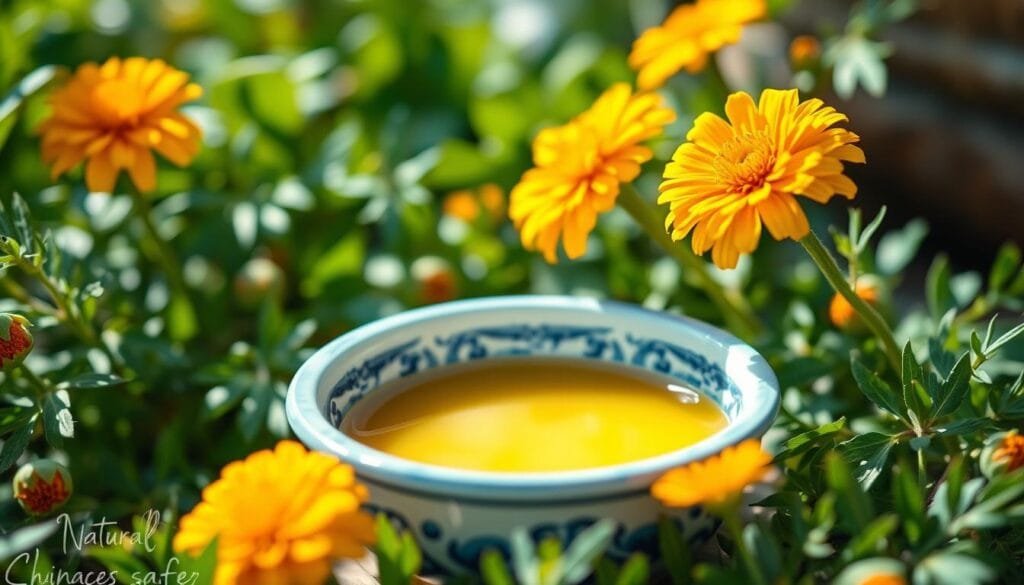
By following these guidelines, you can enjoy calendula’s benefits safely. Always check with a doctor, even for natural ingredients. This is important for your skin’s health.
Incorporating Calendula into Your Daily Skincare Routine
I’ve found that adding calendula to my skincare routine is a game-changer. This flower is not just good for hydrating my skin. It also fights aging and reduces inflammation, making my skin look better.
I start with calendula-based cleansers and toners. They clean my skin gently, keeping it balanced. Then, I use a moisturizer with calendula to keep my skin hydrated.
At night, I use calendula oil for a massage. It makes my skin soft and reduces wrinkles. Calendula really helps slow down aging signs.
When my skin is extra sensitive, I use a calendula spot treatment. It quickly calms redness and irritation. It’s perfect for blemishes.
Lastly, I use a calendula sunscreen every day. It protects my skin from the sun and soothes it. Calendula keeps my skin healthy and protected.
Adding calendula to my skincare routine has made a big difference. My skin looks healthier and more radiant. I highly recommend calendula for anyone wanting better skin.
“Calendula exhibits antibacterial, antiviral, anti-inflammatory, anti-tumor, and antioxidant properties.”
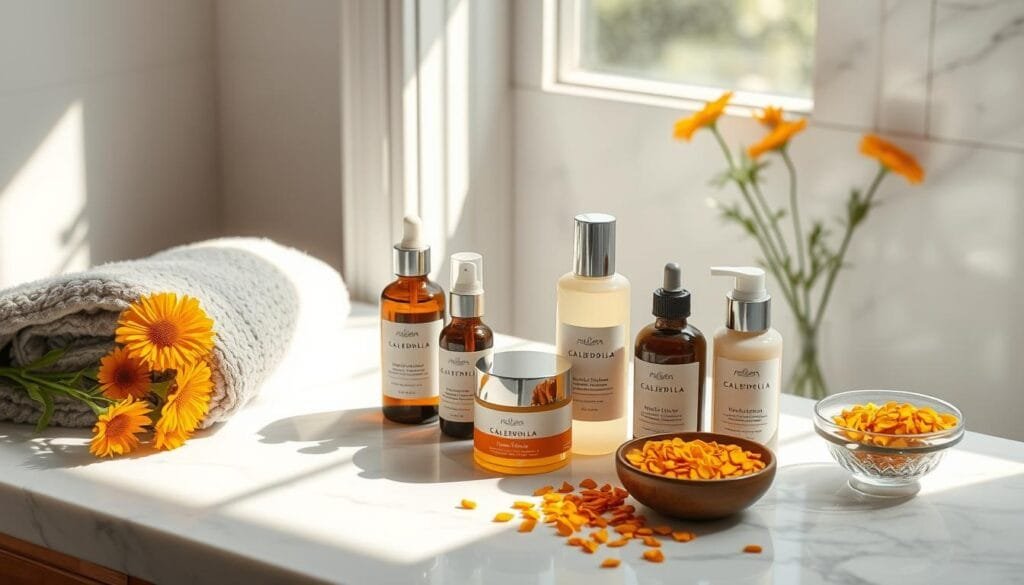
Growing and Harvesting Calendula for Personal Skincare Use
As a home gardener, I’ve found joy in growing my own calendula (Calendula officinalis) for skincare. This vibrant herb is easy to grow and very useful. It’s great for making natural beauty products at home.
I picked the Erfurter Orangefarbige variety of calendula seeds for their strong medicinal benefits. Calendula loves sunny spots with good drainage. It grows well in beds or big pots, adding color to my garden.
When it’s time to harvest, I go to my garden in the mid-morning. This is when the flowers are fully open. I cut the flower heads, making sure to get the green base too. It’s full of good stuff for the skin.
Then, I dry the flowers in a cool, airy place. It takes about 10 days. After they’re dry, I store them in airtight containers. They’re ready to use in oils, creams, and more.
FAQ
What makes calendula different from common marigold?
What are the key compounds found in calendula flowers?
How does calendula promote skin healing?
In what forms is calendula available for skincare use?
How can calendula be used for skin health?
What are the key benefits of calendula for skin health?
How can I make my own calendula-infused skincare products?
What are the recommended usage guidelines for calendula products?
How can I incorporate calendula into my daily skincare routine?
How can I grow and harvest calendula at home?
Source Links
- https://skinkraft.com/blogs/articles/how-to-use-calendula-on-skin
- https://www.healthline.com/health/calendula-oil
- https://www.mustelausa.com/blogs/mustela-mag/calendula-benefits
- https://scratchmommy.com/grow-a-skin-healing-flower-garden/
- https://chestnutherbs.com/topical-uses-of-calendula/
- https://bellecoteparis.com/blogs/beauty/benefits-of-calendula?srsltid=AfmBOoro-0yhlS9nqkuY8Ie44cvS5x3N-ZZZ3CP7JjSx8cOs6JMPgwuZ
- https://www.mountsinai.org/health-library/herb/calendula
- https://curology.com/blog/what-are-the-benefits-of-calendula-for-skin/
- https://www.medicalnewstoday.com/articles/calendula-and-eczema
- https://www.byrdie.com/calendula-for-skin-5214724
- https://www.integrativenutrition.com/blog/calendula-for-skin-benefits-and-uses
- https://www.babobotanicals.com/blogs/news/calendula-benefits?srsltid=AfmBOorB92MkREpq6pw8GvwHAJhPIO1URtb9B5-f9f8_G6okebElT2K7
- https://www.babobotanicals.com/blogs/news/calendula-benefits?srsltid=AfmBOorkpkOPqqEZussIl-179vBStp4HGpHwFg_fs-zazzoViPWCQdnd
- https://jessicasapothecary.com/calendula-for-skin-care/
- https://www.babobotanicals.com/blogs/news/calendula-benefits
- https://pmc.ncbi.nlm.nih.gov/articles/PMC10142266/
- https://www.growforagecookferment.com/how-to-make-calendula-cream/
- https://homesteadandchill.com/homemade-calendula-salve-recipe/?srsltid=AfmBOorzSSedchDyuNnZzU-4c58eYiLL8pm9F-jINAc155pyfWM-YPjF
- https://www.learningherbs.com/blog/calendula-lotion
- https://medlineplus.gov/druginfo/natural/235.html
- https://www.rxlist.com/supplements/calendula.htm
- https://www.babobotanicals.com/blogs/news/calendula-benefits?srsltid=AfmBOoqHX4PRUdvwH6wpKI1b8NvZJpLb4hxnhWg6LrE1kx_U4yGdetqP
- https://www.ipsy.com/blog/calendula-benefits-for-skin
- https://www.potionorganic.com/blogs/news/benefits-of-calendula-in-skincare?srsltid=AfmBOorQEgAOCLHdfiDw7gp43qdAW45cYg2ox7_j9gWKmb0tZBOSly8g
- https://lovelygreens.com/calendula-a-guide-to-growing-using-it-in-skin-care/
- https://howmytexasgardensgrow.com/2017/08/02/how-to-make-calendula-oil-for-skin-care/
- https://homesteadandchill.com/all-about-calendula/?srsltid=AfmBOopdC3AndB-0NZFdlh86kC4CfawZsiEP1onlYfhzfQKUlR5zTIYC
